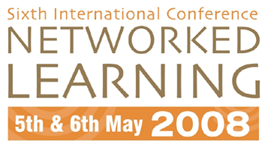

Facilitate the Facilitator: Awareness Tools to Support the Moderator to Facilitate Online Discussions for Networked Learning
Maarten de Laat, Mike Chamrada & Rupert Wegerif
School of Education and Lifelong Learning, The University of Exeter, m.f.delaat@exeter.ac.uk,
mc286@exeter.ac.uk, r.b.wegerif@exeter.ac.uk
Abstract
This paper is part of an ongoing European research project, called ARGUNAUT.
We would like to present some of our findings regarding the development
of online awareness tools supporting the moderator to best facilitate
online discussions. The ARGUNAUT system is based on synchronous learning
and embeds an integrated suite of tools in order to set up and moderate
synchronous discussions. Our focus in this paper is on the Moderators
Interface (MI), which is a tool especially designed for the moderator.
This tool allows moderators to log on to one or more ongoing discussions
and provides the moderator a set of awareness indicators to be used to
remotely facilitate these discussions.
The central idea behind this project is to develop these awareness indicators,
using data mining techniques and artificial intelligence trained on pedagogically
annotated events of teaching and learning activities in online discussions,
to inform the moderator about teaching and learning activities that occur
in online discussions. The challenge is to find ways in which pedagogical
ideas of online argumentation, teaching and learning processes can be
articulated into rules used by the awareness tools to find patterns or
examples of particular networked learning behaviour that signify these
rules.
In this paper we firstly discuss our theoretical orientation towards
online argumentation and dialogues. This results in a multidimensional
analytical framework to analyse synchronous discussions in order to develop
awareness tools for the MI. Secondly an overview of the ARGUNAUT system
is presented focussing on the use of awareness indicators by moderators
to facilitate their facilitation of online discussions. Using the MI the
moderator can select a visualisation of the actual discussion graph as
it is created by the students, in order to read their contributions. Furthermore
the moderator can request various descriptive statistical information
about the number and type of contributions made by students. More advanced
visualisations for example show live interaction patterns of the participants
using social network analysis (SNA) techniques and the Deep Loop classification
of contributions written by the students. The Deep Loop, is an AI-based
awareness indicator that can automatically detect for example if students
are talking of / on-task, critical reasoning and question-answer patterns.
In addition to these awareness indicators the MI provides the moderators
with a remote control which can be used by the moderator to directly facilitate
the discussion. Based on MI observations the moderator can for example
choose to send a pop-up message to a particular student, group of students
or the entire class and guide them in their learning activities.
This paper ends with a discussion of current discourse analysis done by
our team aimed at the identification of important critical moments in
the discussion that feature particular dialogic properties and might need
the attention of the moderator. Our research is currently focused on detecting
patterns within the discussion that show elements of deepening and widening.
When thinking about acts of deepening and widening (critical reasoning
and dialogic reasoning), from a dialogical point of view the widening
moves in particular are of great interest since not much is known about
how widening moves are triggered. A widening move is often a creative
act, i.e. the ability to step back and come with a new ‘solution’
not thought of before. Such moves however are very important in discussions
as they stimulate people to think ‘out of the box’, and or
stimulate further creative thinking amongst the group members. Our preliminary
findings suggests that these critical moments coincide with moments where
a discussion branching into several directions.
If branching events might be an indication of critical moments in the
discussion, we need to see if they can be patterned in some way and test
the possibility of using artificial intelligence to train classifiers.
Being able to detect these moments automatically will mean a major step
forward for online moderation and student engagement in rich dialogues
representing multiple alternative points of view.
| About NLC |
2008 Conference Papers
| Conference Committee| Keynote
Speakers
| Papers from previous NL conferences |Research Seminars| Current Conference
| Sponsors | Contact
|
